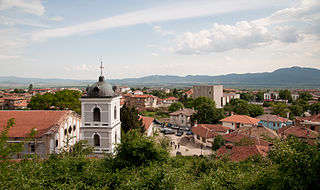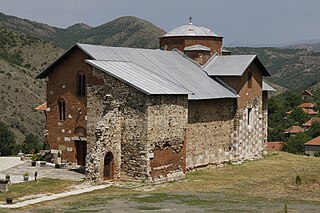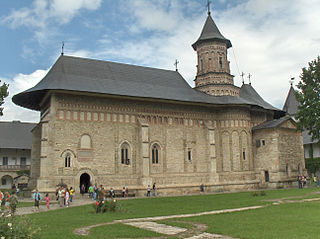
Stephen III of Moldavia, most commonly known as Stephen the Great, was Voivode of Moldavia from 1457 to 1504. He was the son of and co-ruler with Bogdan II, who was murdered in 1451 in a conspiracy organized by his brother and Stephen's uncle Peter III Aaron, who took the throne. Stephen fled to Hungary, and later to Wallachia; with the support of Vlad III Țepeș, Voivode of Wallachia, he returned to Moldavia, forcing Aaron to seek refuge in Poland in the summer of 1457. Teoctist I, Metropolitan of Moldavia, anointed Stephen prince. He attacked Poland and prevented Casimir IV Jagiellon, King of Poland, from supporting Peter Aaron, but eventually acknowledged Casimir's suzerainty in 1459.

Târgoviște is a city in the region of Muntenia, Romania and the county seat of Dâmbovița County. It is situated on the right bank of the Ialomița River.

Suceava is the largest city and the seat of Suceava County, situated in the historical region of Bukovina, north-eastern Romania, and at the crossroads of Central and Eastern Europe. During the late Middle Ages, between 1388 and 1564, the middle-sized town was the capital of the Principality of Moldavia.

Sopot is a Bulgarian town situated in the fertile sub-Balkan mountain valley of Karlovo, immediately below the steep southern slopes of the Troyan Balkan Mountain. Sopot is part of Plovdiv Province and is the administrative centre of a municipality with the same name.

The Putna monastery is a Romanian Orthodox monastery, one of the most important cultural, religious and artistic centers established in medieval Moldavia; as with many others, it was built and dedicated by Stephen the Great. Putna was founded on the lands perambulated by the Putna. Stephen the Great is famous for building and influencing the building of dozens of churches and monasteries all over Moldavia. The Putna Monastery houses the tombs of Stephen —nowadays, a place of pilgrimage —, and several of his family members. The icon veils and tombstones are held as fine examples of Moldavian art in Stephen the Great’s time.

The Banjska Monastery is a Serbian Orthodox monastery in the Banjska village near Zvečan, Kosovo.

The Voroneț Monastery is a medieval monastery in the Romanian village of Voroneț, now a part of the town Gura Humorului. It is one of the famous painted monasteries from southern Bukovina, in Suceava County. The monastery was constructed by Stephen the Great in 1488 over a period of 3 months and 3 weeks to commemorate the victory at Battle of Vaslui. Often known as the "Sistine Chapel of the East", the frescoes at Voroneț feature an intense shade of blue known in Romania as "Voroneț blue."

The Neamț Monastery is a Romanian Orthodox religious settlement, one of the oldest and most important of its kind in Romania. It was built in the 15th century, and it is an example of medieval Moldavian architecture. A jewel of 15th-century architecture, the church was built during the reign of Stephen III of Moldavia (1457–1504) and finished in the year when the Moldavian army won the battle against King John I Albert of Poland (1497).

The Bistrița Monastery is a Romanian Orthodox monastery located 8 km west of Piatra Neamț. It was dedicated in 1402, having as original ctitor the Moldavian Voivode Alexandru cel Bun whose remains are buried here.
The Architecture of Hungary is understood as the architecture of the territory of the country of Hungary, and in a wider, of the Kingdom of Hungary, from the conquest to the present day.

Eastern Christian Monasticism is the life followed by monks and nuns of the Eastern Orthodox Church, Oriental Orthodoxy, the Church of the East and Eastern Catholicism. Eastern monasticism is founded on the Rule of St Basil and is sometimes thus referred to as Basilian.

Cenad is a commune in Timiș County, Romania. It is composed of a single village, Cenad. The village serves as a customs point on the border with Hungary. Today's village was formed by merging Cenadu Mare and Cenadu Vechi in the 20th century.

The Moldovița Monastery is a Romanian Orthodox monastery situated in the commune of Vatra Moldoviței, Suceava County, Moldavia, Romania. The Monastery of Moldovița was built in 1532 by Petru Rareș, who was Stephen III of Moldavia's illegitimate son. It was founded as a protective barrier against the Muslim Ottoman conquerors from the East.
Romanian architecture is diverse, including medieval architecture, modern era architecture, interwar architecture, communist architecture, and contemporary 21st century architecture. In Romania, there are also regional differences with regard to architectural styles.

Daniil Sihastrul (Romanian for "Daniel the Hesychast"; was a renowned Romanian Orthodox spiritual guide, advisor of Stephen the Great, and hegumen of Voroneț Monastery. Canonized by the Romanian Orthodox Church in 1992, he is commemorated on December 18.

Stephen, traditionally venerated as the protomartyr or first martyr of Christianity, was, according to the Acts of the Apostles, a deacon in the early Church at Jerusalem who angered members of various synagogues by his teachings. Accused of blasphemy at his trial, he made a speech denouncing the Jewish authorities who were sitting in judgment on him and was then stoned to death. Saul of Tarsus, later known as Paul, a Pharisee and Roman citizen who would later become a Christian apostle, participated in Stephen's martyrdom.

The Archdiocese of Râmnic is a Romanian Orthodox archdiocese based in Râmnicu Vâlcea, Romania, in the historic region of Oltenia, and covering Vâlcea County. Established in 1503-1504, although with a bishop residing there from the previous century, it is a continuation of the medieval Metropolis of Severin. Initially covering all of Oltenia, it saw a flourishing cultural and religious output during the 16th to 18th centuries, both in the see and in the monasteries of the region. The area of the diocese began to fall in 1939, reaching its current proportions in 2008, a year before it became an archdiocese.

The Nativity of St. John the Baptist Church, located at 2 Piața Libertății, Piatra Neamț, Romania, is a Romanian Orthodox church. Established by Prince Stephen the Great of Moldavia, it was built in 1497-1498 as part of his royal court in the town. The bell tower dates to the year after the church was completed, and is a symbol of the city. Both church and tower are well preserved examples of late 15th century Moldavian religious architecture.

Saint Sabbas Church is a Romanian Orthodox church located at 44 Costache Negri Street in Iași, Romania. It is dedicated to Saint Sabbas the Sanctified.
Tazlău Monastery is a Romanian Orthodox Christian monastery located at 188 Ștefan cel Mare Street, Tazlău, Neamț County, Romania.



































